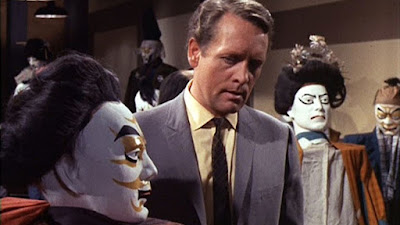The Prisoner Episodes Paired as Films: Koroshi and Shinda Shima
The introduction to this series of posts can be found here.
As I stated in the introduction the purpose of these posts is to examine several episodes of Danger Man and The Prisoner in pairs to see how they work and particularly to identify any structure. So I have identified the following repeat structure in Koroshi and Shinda Shima, the final episodes of Danger Man, which were also joined together as a film.
A Japanese female spy is pursued and killed.
B Drake arrives in Tokyo as Edwards.
C Potter gives him a record.
D The record includes a picture of an emblem.
E Drake seeks an explanation of the emblem from an old wise man.
Drake meets Rosemary
F Rosemary takes Drake to see Nigel Saunders. (Inversion of the going to the wise wo/man motif at E)
G Drake is introduced to the death cult through the very heavy hint of a koroshi murder scene.
H A man tries to kill Drake.
I Drake saves Rosemary from a murder attempt.
J The purpose of the death brotherhood is to end rule by the people.
K There is a mass struggle.
L Saunders dies.
A Skin diver is attacked and killed underwater.
B Sharp arrives at Tokyo and tells them he's resigned - Drake takes his place.
C Drake is given a packet intended for Sharp.
D The packet contains a small jigsaw of a two-tailed dragon
E Drake seeks the explanation of the jigsaw from a woman in a bar.
Drake goes to the island depicted in the jigsaw and meets his contact who tells him a story that the next island is cursed.
F Drake is taken to the island by a hooded man. (Inversion of the going to the wise wo/man motif at E)
G Drake is introduced to the organisation in its hideout on the island.
H Mio tries to kill Drake.
I Drake is appointed Mio's executioner but helps her escape the island.
J Drake encourages he exiled people of Shinda Shima to return to the island and take it back.
K There is a mass struggle.
L The boss of the organisation dies.
This would therefore agree with the structure mooted in the introduction that Shinda Shima should be a related episode to Koroshi. I honestly wasn't expecting what I have seen, but I spotted this structural relationship as soon as I started watching them. I actually think that the role of the baddie in the two episodes (equating to the role of Number 2 in The Prisoner) isn't as close as I was expecting it to be. In Koroshi the baddie is disguised as a goodie, whereas in Shinda Shima it is clear that he is never anything other than the head of a criminal organisation, which is after the pearls of the island. I wasn't expecting this to happen.
Additionally I have noticed numerous elements of the two episodes which reflect aspects of The Prisoner which I haven't noticed before: the gas from flowers, shot of keyhole, the resigned official, Rosemary's flat reflects Number 6's house,
Since the point of this is the comparison with joined-up episodes of The Prisoner I have also compared this structure to Arrival (I am assuming for now that the doubled-up episodes of The Prisoner would match the repetitive structure of Koroshi and Shinda Shima). Arrival has a surprising number of the same elements but rearranges them slightly and duplicates or misses others.
A The resignation scene echoes the death scenes in the two earlier episodes: it is Number 6's professional role which has died though. The keyhole and gas scene echoes the deathly flowers scenes in Koroshi but without fatal intent.
B Number 6 wakes up in the Village.
C1 The shopkeeper gives him a map.
D The map has the Village's penny farthing emblem.
E Number 2 goes to see Number 6 and demands an explanation.
C2 Number 2 shows him his file.
G Number 2 is introduced to the Village by NUmber 6's tour.
H1 Rover appears to kill the man in the fountain.
H2 Number 2 tries to escape and Rover appears to kill him.
H3 Cobb appears to die in the hospital.
M Change of Number 2.
I (inverted) Number 9 tricks him into trying to escape.
(That J,K and L are missing suggests that The Prisoner reflects a state of passive population who will not resist but go along with their captivity)
In conclusion: a comparison of Koroshi and Shinda Shima have revealed significant structural repetition between the two episodes but not the repetition of the role of the baddie which I was expecting. I also noticed significant echoes of aspects of The Prisoner.
I have been surprised to find such structural similarities in Arrival but would also note that most of the motifs of Koroshi are reversed: the deaths are only apparent and the people are compliant to their masters. There are, however, also a number of differences which indicate a different emphasis. I would conclude that Koroshi and Shinda Shima are clearly structurally related with the overarching theme of a death cult aiming to stop rule by the people. Arrival, while related, has a greater emphasis on things not being what they seem and on the individual having to rely on himself rather than the people.
https://www.theunmutual.co.uk/article58.htm
https://david-stimpson.blogspot.com/2011/05/seven-episodes-of-prisoner.html?m=1
https://odysee.com/@DVDvision:7/the-prisoner-1967-lost-items-3-the-2:9
Proud to be a member of the Guardian-reading, tofu-eating wokerati and the anti-growth coalition. wesayenough.co.uk - tactical.vote
This blog is mirrored at culttvblog.blogspot.com and culttvblog.substack.com (where you can still subscribe by email if you want). There is an index to posts on the Substack version at https://culttvblog.substack.com/p/index-to-posts
If you want to support me and this blog, you can buy me a coffee or a box set at ko-fi.com/culttvblog
